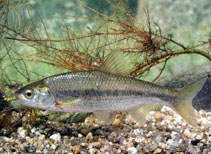Telestes montenigrinus (Vukovic, 1963)
Add your observation in Fish WatcherAquaMaps webservice down at the moment
Upload your photos and videos
Pictures | Google imageTelestes montenigrinus
Picture by Pialek, L.
Pictures | Google imageTelestes montenigrinus
Picture by Pialek, L.
Classification / Names Nomi Comuni | Sinonimi | Catalog of Fishes(Genere, Specie) | ITIS | CoL | WoRMS | Cloffa
> Cypriniformes (Carps) > Leuciscidae (Minnows) > Leuciscinae
Eponymy: The etymology is not explained by Bonaparte, and it may not be an eponym. However, Telestes was the name of the last king of ancient Corinth (748 BC) and of a poet of 5th-century Greece, so the name might refer to one of these. (Ref. 128868), visit book page.
Eponymy: The etymology is not explained by Bonaparte, and it may not be an eponym. However, Telestes was the name of the last king of ancient Corinth (748 BC) and of a poet of 5th-century Greece, so the name might refer to one of these. (Ref. 128868), visit book page.
Environment: milieu / climate zone / depth range / distribution range Ecologia
; acqua dolce benthopelagico. Subtropical; 43°N - 42°N, 19°E - 20°E
Distribuzione Stati | Aree FAO | Ecosystems | Presenze | Point map | Introduzioni | Faunafri
Europe: Lake Skadar basin (Montenegro, Albania).
Size / Peso / Age
Short description Chiavi di identificazione | Morfologia | Morfometria
Diagnosed from its congeners by the possession of the following characters: 45-49 + 2-3 scales on lateral line; anal fin usually with 9½ branched rays; eye diameter 3.4-3.5 times in HL, 1.1-1.3 times in interorbital distance; snout pointed, not projecting beyond tip of upper lip; conspicuous black midlateral stripe and conspicuous black line along lateral line in preserved individuals (Ref. 59043).
Occurs in a wide range of habitats from small mountain streams to lake shores. Reported to feed on plankton and bottom fauna (Ref. 59043).
Life cycle and mating behavior Maturità | Riproduzione | Deposizione | Uova | Fecundity | Larve
Main reference
Upload your references | Bibliografia | Coordinatore | Collaboratori
Kottelat, M. and J. Freyhof, 2007. Handbook of European freshwater fishes. Publications Kottelat, Cornol and Freyhof, Berlin. 646 pp. (Ref. 59043)
IUCN Red List Status (Ref. 130435: Version 2024-2)
Near Threatened (NT) (Near Threatened); Date assessed: 06 December 2023
CITES
Not Evaluated
Threat to humans
Harmless
Human uses
FAO - Publication: search | FishSource |
Informazioni ulteriori
Trophic ecology
Prede
Alimentazione
Consumo di cibo
Food rations
Predatori
Prede
Alimentazione
Consumo di cibo
Food rations
Predatori
Ecology
Ecologia
Ecologia
Population dynamics
Growth parameters
Max. ages / sizes
Length-weight rel.
Length-length rel.
Length-frequencies
Mass conversion
Reclutamento
Abbondanza
Growth parameters
Max. ages / sizes
Length-weight rel.
Length-length rel.
Length-frequencies
Mass conversion
Reclutamento
Abbondanza
Life cycle
Riproduzione
Maturità
Maturity/Gills rel.
Fecundity
Deposizione
Spawning aggregations
Uova
Egg development
Larve
Dinamica popolazioni larvali
Riproduzione
Maturità
Maturity/Gills rel.
Fecundity
Deposizione
Spawning aggregations
Uova
Egg development
Larve
Dinamica popolazioni larvali
Anatomy
Area branchiale
Brain
Otolith
Area branchiale
Brain
Otolith
Physiology
Body composition
Nutrients
Oxygen consumption
Swimming type
Swimming speed
Visual pigments
Fish sound
Diseases & Parasites
Toxicity (LC50s)
Body composition
Nutrients
Oxygen consumption
Swimming type
Swimming speed
Visual pigments
Fish sound
Diseases & Parasites
Toxicity (LC50s)
Genetics
Genetica
Heterozygosity
Ereditarietà
Genetica
Heterozygosity
Ereditarietà
Human related
Aquaculture systems
Profili di acquacoltura
Varietà
Ciguatera cases
Stamps, coins, misc.
Aquaculture systems
Profili di acquacoltura
Varietà
Ciguatera cases
Stamps, coins, misc.
Strumenti
E-book | Giuda pratica | Generatore frequenze di lunghezza | Strumento Parametri Biologici | Mappa dei ritrovamenti | Classification Tree
| Catch-MSY |
Special reports
Download XML
Fonti Internet
AFORO (otoliths) | Aquatic Commons | BHL | Cloffa | BOLDSystems | Websites from users | Check FishWatcher | CISTI | Catalog of Fishes: Genere, Specie | DiscoverLife | ECOTOX | FAO - Publication: search | Faunafri | Fishipedia | Fishtrace | GenBank: genome, nucleotide | GloBI | Google Books | Google Scholar | Google | IGFA World Record | MitoFish | Otolith Atlas of Taiwan Fishes | PubMed | Reef Life Survey | Socotra Atlas | Tree of Life | Wikipedia: Go, ricerca | World Records Freshwater Fishing | Zoological Record
Estimates based on models
Phylogenetic diversity index (Ref. 82804): PD50 = 0.5000 [Uniqueness, from 0.5 = low to 2.0 = high].
Bayesian length-weight: a=0.00813 (0.00374 - 0.01767), b=3.10 (2.92 - 3.28), in cm total length, based on LWR estimates for this (Sub)family-body shape (Ref. 93245).
Trophic level (Ref. 69278): 3.3 ±0.4 se; based on size and trophs of closest relatives
Resilienza (Ref. 120179): Medio, tempo minimo di raddoppiamento della popolazione 1.4 - 4.4 anni (Preliminary K or Fecundity.).
Fishing Vulnerability (Ref. 59153): Low vulnerability (10 of 100).




